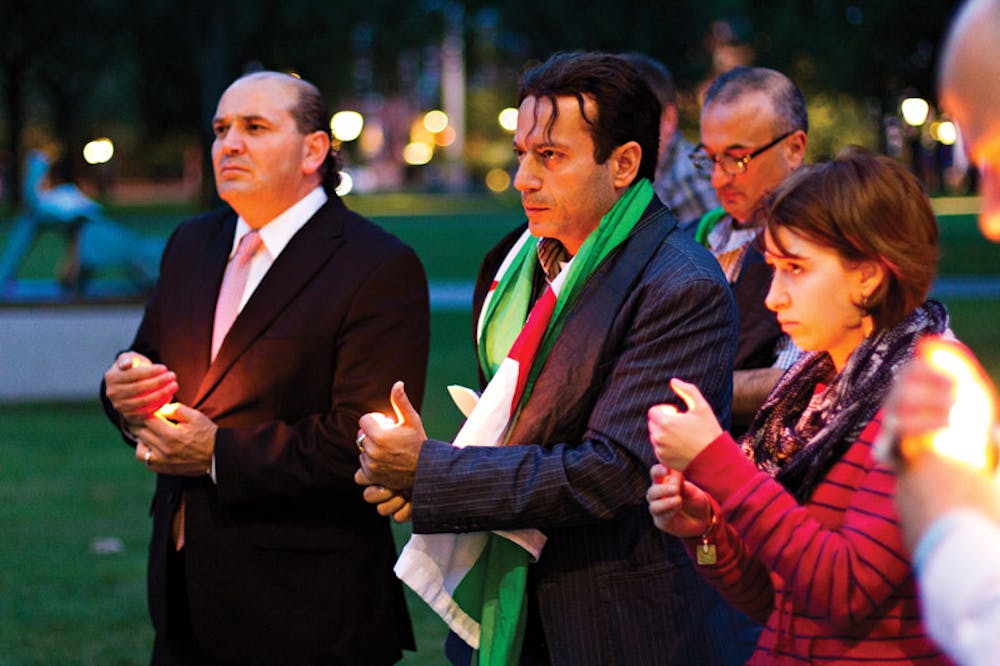The Syrian civil war “is not a clear-cut situation of right and wrong,” said Beshara Doumani, director of Middle East Studies and professor of history, Monday afternoon while introducing a teach-in on the crisis sponsored by the Middle East Studies program.
The teach-in, designed to explain and discuss the current turmoil in Syria, began with a moment of silence for victims of violence, not only in Syria but also all over the world. After the teach-in, the Office of Chaplains and Religious Life staged a candlelight vigil on the Main Green. A small group of people congregated in front of the Stephen Robert ’62 Campus Center to pray for the Syrian people as well as for a speedy and peaceful resolution of the conflict.
The event was scheduled to take place in List 120, but the crowd quickly overwhelmed the auditorium, forcing organizers to send spillover next door to watch a live-stream of the event, which was available online.
The teach-in comprised four sections, each featuring a mini-lecture by a member of the University’s faculty. Besides Doumani, other participants of the teach-in included Mayssun Succarie, Cogut postdoctoral fellow in international humanities and modern Arab culture and society; Elias Muhanna, assistant professor of comparative literature; and Naoko Shibusawa, associate professor of history.
Succarie, the first speaker, provided an overview and timeline of recent events in Syria. She described the conflict as composed of “four stages, layered upon each other.” What is now a civil war began in 2011 with a relatively peaceful protest in response to the torture of teenagers who publicly opposed the regime, she said. Since then, the country has militarized, leading to the uprising and civil war at the middle of the today’s crisis, she said.
Extreme poverty and political repression also contributed to the growth of the conflict, Succarie added.
Doumani spoke about the civil war’s historical context, putting the fragmentation of the rebel groups in perspective. Though Syria has a long history of internal division, “this civil war is not just another flare-up of an ancient sectarian conflict,” he said. “It’s part and parcel of a larger global phenomenon,” related to the victorious Allied countries drawing arbitrary borders for Middle Eastern countries after World War I, he added.
Some students said they appreciated the longer view of the day-to-day news out of Syria. “I thought it was interesting how they brought up the background (of the conflict),” said Yidi Wu ’17. “I wasn’t really familiar with all of that.”
“I found in particular that the background … was informative and rare in the discourse on the issue,” added Ezra Kagan ’17.
Muhanna said today’s Middle East is defined by a complicated set of historic and modern alliances and animosities. He added that the many rebel groups fighting on the ground in Syria vary widely in terms of numbers, funding and ideology.
In particular, the rebels’ “sources of funding are significantly more dispersed than in any other Middle Eastern conflict in recent memory,” he said. In general, this contributes to “the muddiness of geo-strategic relations in the Middle East today,” he added.
Shibusawa focused on America’s position and the political choice that President Obama and the White House currently face. Though the decision to intervene in Syria is hotly debated and widely disapproved of by the public, the government can depend on people “rallying around the flag” and supporting the move once the choice is made, she said.
Shibusawa also discussed the reasons behind a military intervention, particularly what she called the self-serving interests of the “military-industrial-congressional-media complex” and what she called the Obama administration’s need to save face.
“The sad and the terrible, awful truth about it is that this seems to matter more,” she said. “Whether or not this is going to be a test of leadership that Obama can live up to is more important than the fact that thousands and thousands of lives are on the line.”
The event ended with a brief period for questions and comments, when members of the audience were encouraged to stand up and contribute their opinions to the discussion.
“Overall, I thought (the teach-in) was really good,” said Caroline Doherty ’15, who said she attended because she owed it to herself to learn more about the conflict. “I had a very basic idea of the history of the Middle East, and I didn’t realize how complicated everything was and how many different factors there were that built up to all of this.”
“It’s wonderful that we had this opportunity to have this” teach-in, Shibusawa said in her lecture. “These conversations … really allow us to get a better sense of what’s going on.”

ADVERTISEMENT




